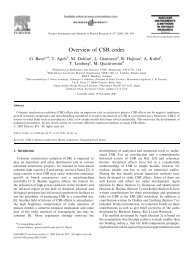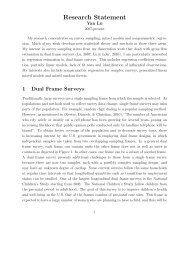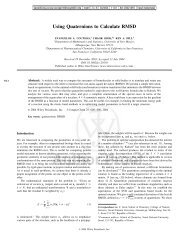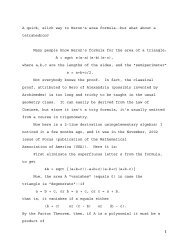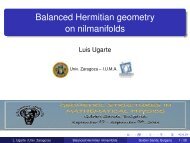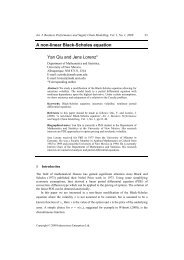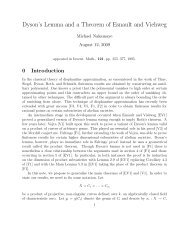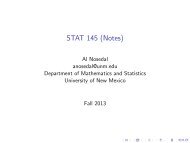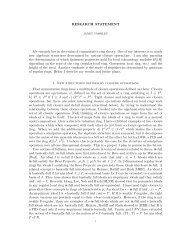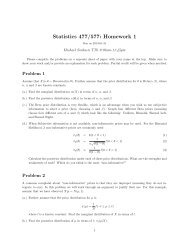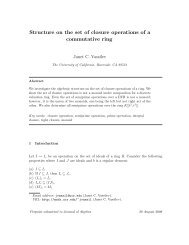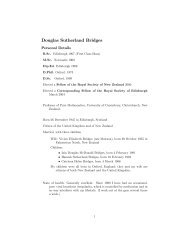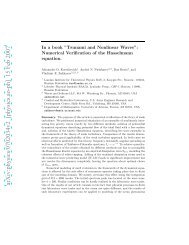OEO Office of Equal Opportunity - Department of Mathematics and ...
OEO Office of Equal Opportunity - Department of Mathematics and ...
OEO Office of Equal Opportunity - Department of Mathematics and ...
Create successful ePaper yourself
Turn your PDF publications into a flip-book with our unique Google optimized e-Paper software.
242 ARTS AND SCIENCES<br />
103. [103–104.] Basic Medical Navajo. (3, 3) Willink<br />
Fundamentals <strong>of</strong> Navajo for students in the medical pr<strong>of</strong>ession.<br />
Does not satisfy language requirement <strong>of</strong> College <strong>of</strong><br />
Arts <strong>and</strong> Sciences. {Offered upon dem<strong>and</strong>}<br />
105. Written Navajo for Native Speakers. [Written<br />
Navajo.] (3) Willink<br />
Introduction to Navajo writing <strong>and</strong> reading; for native speakers<br />
<strong>of</strong> Navajo only. 101 <strong>and</strong> 105 may not both be counted<br />
for credit.<br />
201–202. Intermediate Navajo. (3, 3) Willink<br />
Intermediate Navajo for students who have completed 102 or<br />
105, or equivalent. Continued development <strong>of</strong> all four skills.<br />
Prerequisite: (101–102) or 105. {201–Fall, 202–Spring}<br />
206. Creative Writing <strong>and</strong> Advanced Reading. (3) Willink<br />
For native speakers <strong>of</strong> Navajo only.<br />
Prerequisite: 105.<br />
311./511. Navajo Verb System I. (3)<br />
This course emphasizes Navajo grammar <strong>and</strong> introduces<br />
students to the prefix template <strong>of</strong> the Navajo verb. Verb<br />
paradigms in the imperfective are covered using a variety <strong>of</strong><br />
literary <strong>and</strong> cultural materials.<br />
Prerequisite: 202 or 206.<br />
312./512. Navajo Verb System II. (3)<br />
The course continues study <strong>of</strong> the verb paradigms in Navajo<br />
<strong>and</strong> introduces the perfective, usitative, iterative, progressive<br />
<strong>and</strong> future modes using a variety <strong>of</strong> literary <strong>and</strong> cultural material.<br />
Discussion includes Navajo aspectual variation, stem<br />
alternations <strong>and</strong> conjugation patterns.<br />
Prerequisite: 301.<br />
315./515. Advanced Navajo. (3)<br />
An examination <strong>of</strong> Navajo syntax, including voice alternations<br />
(passive, causative), relative <strong>and</strong> subordinate clause<br />
constructions <strong>and</strong> discourse structure.<br />
Prerequisite: 202.<br />
401./501. Navajo Linguistics. (3 to a maximum <strong>of</strong> 12) ∆<br />
Introduction to linguistics in Navajo including phonetics <strong>and</strong><br />
phonology, grammar, semantics, pragmatics <strong>and</strong> sociolinguistics.<br />
Prerequisite: 202.<br />
495. Undergraduate Problems. (1-6 to a maximum <strong>of</strong><br />
6) ∆ Willink<br />
Restriction: permission <strong>of</strong> instructor.<br />
501./401. Navajo Linguistics. (3 to a maximum <strong>of</strong> 12) ∆<br />
Introduction to linguistics in Navajo including phonetics <strong>and</strong><br />
phonology, grammar, semantics, pragmatics <strong>and</strong> sociolinguistics.<br />
Prerequisite: 202.<br />
511./311. Navajo Verb System I. (3)<br />
This course emphasizes Navajo grammar <strong>and</strong> introduces<br />
students to the prefix template <strong>of</strong> the Navajo verb. Verb<br />
paradigms in the imperfective are covered using a variety <strong>of</strong><br />
literary <strong>and</strong> cultural materials.<br />
Prerequisite: 202 or 206.<br />
512./312. Navajo Verb System II. (3)<br />
The course continues study <strong>of</strong> the verb paradigms in Navajo<br />
<strong>and</strong> introduces the perfective, usitative, iterative, progressive<br />
<strong>and</strong> future modes using a variety <strong>of</strong> literary <strong>and</strong> cultural material.<br />
Discussion includes Navajo aspectual variation, stem<br />
alternations <strong>and</strong> conjugation patterns.<br />
Prerequisite: 301.<br />
515./315. Advanced Navajo. (3)<br />
An examination <strong>of</strong> Navajo syntax, including voice alternations<br />
(passive, causative), relative <strong>and</strong> subordinate clause<br />
constructions <strong>and</strong> discourse structure.<br />
Prerequisite: 202.<br />
595. Graduate Problems. (1-6)<br />
Original independent study project approved by instructor.<br />
Restriction: permission <strong>of</strong> instructor.<br />
Signed Language Interpreting<br />
(SIGN)<br />
(For major study requirements, see Linguistics.)<br />
201. Introduction to Signed Language. (3) Naughton,<br />
Santiago, P. Wilcox<br />
Overview <strong>of</strong> signed language studies <strong>and</strong> related issues.<br />
Introduction to American Sign Language (ASL); signed communication<br />
systems most frequently used by deaf <strong>and</strong> hard <strong>of</strong><br />
hearing individuals; the study <strong>of</strong> fingerspelling.<br />
210. American Sign Language I. (3) Naughton, Rudy,<br />
Santiago<br />
Study <strong>of</strong> ASL, including basic concepts <strong>and</strong> sign lexicon.<br />
Grammatical features <strong>of</strong> ASL will be stressed, along with<br />
structure <strong>and</strong> syntax. The student will be expected to demonstrate<br />
to the instructor his or her pr<strong>of</strong>iciency at the end <strong>of</strong><br />
the semester.<br />
Prerequisite: 201. Restriction: permission <strong>of</strong> instructor.<br />
211. American Sign Language II. (3) Naughton, Rudy<br />
A study <strong>of</strong> ASL including sign language colloquialisms used<br />
in conversational signing. Provides a summary <strong>of</strong> information<br />
currently available dealing with the underst<strong>and</strong>ing <strong>of</strong> ASL<br />
grammatical structure <strong>and</strong> its sociolinguistic usage.<br />
Prerequisite: 210. Restriction: permission <strong>of</strong> instructor.<br />
212. Fingerspelling I. (3) Santiago, P. Wilcox<br />
Assists the student in acquiring fluent fingerspelling ability<br />
through the use <strong>of</strong> visual <strong>and</strong> expressive drills. Videotapes<br />
<strong>of</strong> a variety <strong>of</strong> fingerspelling styles will be used to ensure that<br />
the student acquires a comprehensive background.<br />
Prerequisite: 201. Restriction: permission <strong>of</strong> instructor.<br />
214. Lexical Semantics for Transliteration. (3) P. Wilcox<br />
Examines polysemy <strong>of</strong> the English lexicon which transliterators<br />
must be concerned with, ranging from semantic prototypes to<br />
word meanings which are essentially fluid. Signs representing<br />
English morphology are also discussed.<br />
Prerequisite: 201. Restriction: permission <strong>of</strong> instructor.<br />
*305. Signed Language Linguistics. (3) S. Wilcox<br />
Examines linguistic research on signed languages, primarily<br />
ASL: phonetics, phonology, morphology, syntax <strong>and</strong><br />
semantics. Also covers signed language sociolinguistics,<br />
psycholinguistics, language acquisition (first <strong>and</strong> second)<br />
<strong>and</strong> neurolinguistics.<br />
Prerequisite: 210 <strong>and</strong> LING 101. Restriction: permission <strong>of</strong><br />
instructor.<br />
*310. American Sign Language III. (3) Rudy<br />
Designed to help students improve their expressive skills<br />
<strong>and</strong> general conversational competence in ASL relative to<br />
phonology, lexical items, syntax <strong>and</strong> discourse. Focuses on<br />
semantic appropriateness <strong>and</strong> accuracy <strong>of</strong> particular lexical<br />
items, appropriate use <strong>of</strong> non-manual behaviors <strong>and</strong> the use<br />
<strong>of</strong> context to determine meaning.<br />
Prerequisite: 211. Restriction: permission <strong>of</strong> instructor.<br />
320. American Sign Language IV. (3) Rudy<br />
Intensive practice involving receptive/expressive skills in<br />
complex grammatical structures, dialogue <strong>and</strong> storytelling.<br />
Intensive study <strong>of</strong> transcription techniques <strong>and</strong> their applications<br />
to ASL research <strong>and</strong> documentation.<br />
Prerequisite: 310. Restriction: permission <strong>of</strong> instructor.<br />
*352. Language <strong>and</strong> Culture in the Deaf Community,<br />
Part 1. (3) S. Wilcox<br />
An introduction to Deaf culture. Examines the language,<br />
education, social <strong>and</strong> political aspects <strong>and</strong> art forms <strong>of</strong> Deaf<br />
people from an anthropological point <strong>of</strong> view.<br />
353. Language <strong>and</strong> Culture in the Deaf Community,<br />
Part 2. (3)<br />
Continues developing a thorough underst<strong>and</strong>ing <strong>of</strong> the issues<br />
related to signed languages <strong>and</strong> Deaf culture. Cross-cultural<br />
issues <strong>and</strong> the history <strong>of</strong> Deaf people also will be addressed.<br />
Taught in ASL.<br />
Prerequisite: 310 <strong>and</strong> 352.<br />
UNM CATALOG 2006–2007 Symbols, page 611.



